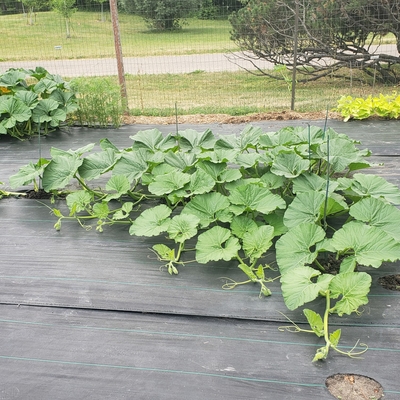Week of June 27
We were lucky to receive some rain this week, allowing our pumpkins to get a much-needed break from the heat.
Several more squash vine borers were spotted, so insecticide was sprayed to protect the plants. With the recent removal of aluminum foil from the pumpkin’s main stem, we worried about squash vine borer damage becoming an issue while the stem becomes woodier.
Both pumpkin plants have increased tremendously, with the northern and southern plants reaching approximately six feet. As the vines spread across the plot, we started to cut holes through the landscape fabric. Cutting holes in the fabric allows the vines to root in the soil underneath.
As the vines grow longer, nutrients have further to travel. By burying sections of the vine, roots are able to grow and provide valuable nutrients to sections that may have received less.
Week of July 4
As the pumpkins flourish, growing what seems like feet of vine per day, space for the Hubbard squash grows smaller. We removed two of the Hubbard plants and will likely remove several more as the pumpkin’s vines continue to spread across the plot. Removing the Hubbard squash will decrease competition for nutrients between the giant pumpkins and the pollinator and trap plants.
Now that the pumpkin vines have started to cover more space, we are beginning to organize their layout to maximize sunlight and nutrients in the soil.
Pumpkin vines come in three main categories, the main vine, secondary runners and tertiary runners. The main pumpkin vine is the stem connected directly to where the pumpkin roots. Secondary runners are vines that have formed off of the main stem, and tertiary runners form off of secondary runners.
As the pumpkin grows, we are not allowing its main vine to exceed 15 feet. Having larger vines can divert nutrients away from pumpkins in the future.
Other news
The signage for the Giant Pumpkin patch has arrived and been placed in front of the plot! Hopefully, with the correct signage, there may be fewer confused faces from visitors.




